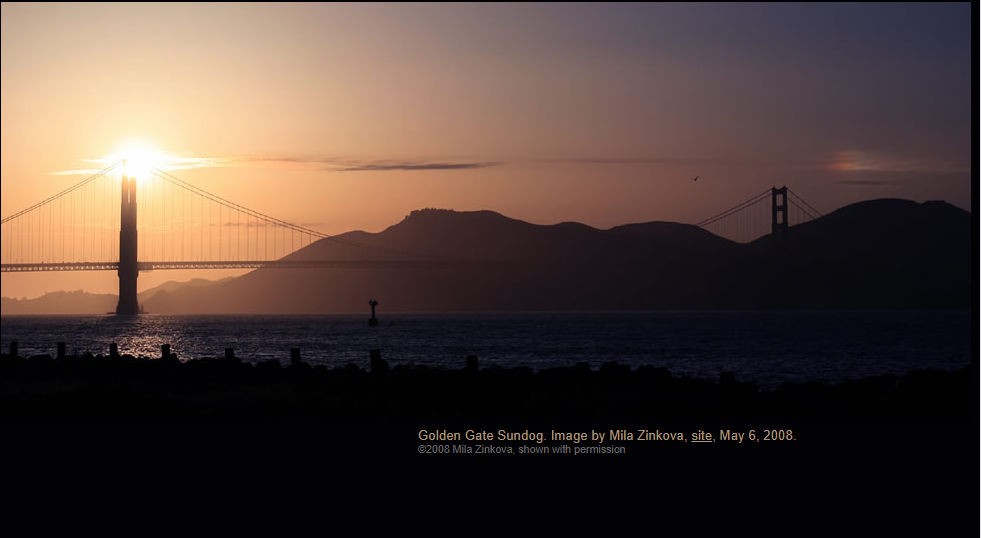Golden Gate Sundog
Golden Gate Sundog: A Rare Atmospheric Phenomenon
Have you ever witnessed a breathtaking display of light in the sky that left you in awe? One such extraordinary atmospheric phenomenon is the Golden Gate Sundog. This captivating sight occurs when sunlight interacts with ice crystals in the atmosphere, creating a stunning halo of light around the sun. In this article, we will delve into the intricacies of the Golden Gate Sundog, exploring its formation, characteristics, and the science behind its mesmerizing appearance.
What is a Sundog?
Before we dive into the specifics of the Golden Gate Sundog, let's understand what a sundog is in general. Sundogs, also known as parhelia, are optical phenomena that occur when sunlight passes through hexagonal ice crystals suspended in the atmosphere. These ice crystals act as tiny prisms, refracting and reflecting sunlight, resulting in the formation of two bright spots on either side of the sun.
The Unique Beauty of the Golden Gate Sundog
The Golden Gate Sundog is a rare variation of the sundog phenomenon that occurs in the vicinity of the iconic Golden Gate Bridge in San Francisco, California. What sets this particular sundog apart is its vibrant colors and distinct appearance. Unlike traditional sundogs, which often display white or pale hues, the Golden Gate Sundog exhibits vivid shades of red, orange, and yellow. This breathtaking spectacle creates a harmonious interplay of colors against the backdrop of the cityscape and the majestic bridge, leaving onlookers spellbound.
Formation of the Golden Gate Sundog
The formation of the Golden Gate Sundog follows the same principles as other sundogs. It begins with the presence of high-altitude cirrus clouds composed of ice crystals. As sunlight passes through these ice crystals, it undergoes refraction, bending the light rays and separating them into different colors. This dispersion creates a spectrum of colors similar to a rainbow. The unique colors of the Golden Gate Sundog can be attributed to the specific size and orientation of the ice crystals, which influences the degree of light refraction and color separation.
Atmospheric Conditions and Occurrence
The occurrence of the Golden Gate Sundog is dependent on specific atmospheric conditions. Firstly, the presence of high-altitude cirrus clouds is crucial, as these clouds contain the necessary ice crystals for the formation of sundogs. Additionally, the angle of the sunlight plays a vital role. Sundogs are most commonly observed when the sun is near the horizon, such as during sunrise or sunset. The low angle of the sun allows the sunlight to pass through a greater portion of the atmosphere, increasing the likelihood of encountering ice crystals and experiencing the Golden Gate Sundog.
The Science Behind the Golden Gate Sundog
The science behind the Golden Gate Sundog lies in the interaction between sunlight and ice crystals. As sunlight passes through an ice crystal, it refracts and reflects off the crystal's facets. The specific angles and shapes of these facets determine the direction and intensity of the refracted light. When multiple ice crystals align in a particular orientation, they collectively produce the distinct halo effect around the sun, giving rise to the Golden Gate Sundog.
Capturing the Golden Gate Sundog
Witnessing the Golden Gate Sundog is undoubtedly a memorable experience, and capturing it in photographs allows us to relive its enchanting beauty. To photograph this phenomenon, it is essential to have a camera capable of capturing fine details and vibrant colors. Additionally, selecting a suitable location with an unobstructed view of the Golden Gate Bridge and positioning yourself at an optimal angle can enhance your chances of capturing this remarkable event. Patience is key, as the appearance of the Golden Gate Sundog is rare and unpredictable.
Appreciating Nature's Wonders
The Golden Gate Sundog serves as a reminder of nature's intricate and awe-inspiring beauty. It invites us to pause, appreciate, and marvel at the wonders that exist beyond our everyday lives. This rare atmospheric phenomenon not only captivates our visual senses but also sparks curiosity about the scientific principles that govern our natural world. So, the next time you find yourself gazing at the sky, keep an eye out for the Golden Gate Sundog and let its ethereal presence fill you with wonder and appreciation for the extraordinary phenomena that surround us.

Golden Gate Sundog. Image by Mila Zinkova, site, May 6, 2008.
©2008 Mila Zinkova, shown with permission
Note: this article has been automatically converted from the old site and may not appear as intended. You can find the original article here.
Reference Atmospheric Optics
If you use any of the definitions, information, or data presented on Atmospheric Optics, please copy the link or reference below to properly credit us as the reference source. Thank you!
-
<a href="https://atoptics.co.uk/blog/golden-gate-sundog/">Golden Gate Sundog</a>
-
"Golden Gate Sundog". Atmospheric Optics. Accessed on December 20, 2024. https://atoptics.co.uk/blog/golden-gate-sundog/.
-
"Golden Gate Sundog". Atmospheric Optics, https://atoptics.co.uk/blog/golden-gate-sundog/. Accessed 20 December, 2024
-
Golden Gate Sundog. Atmospheric Optics. Retrieved from https://atoptics.co.uk/blog/golden-gate-sundog/.